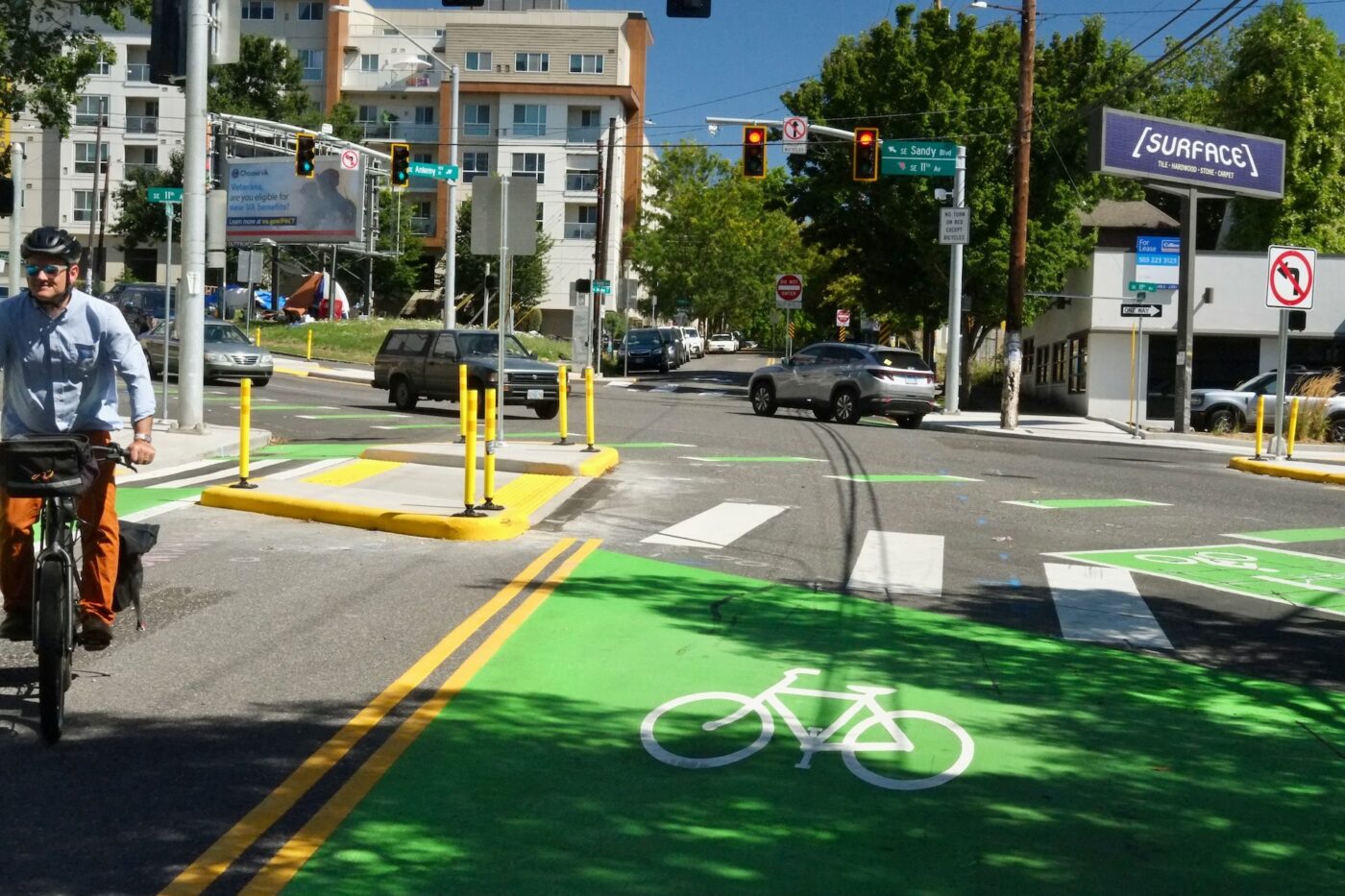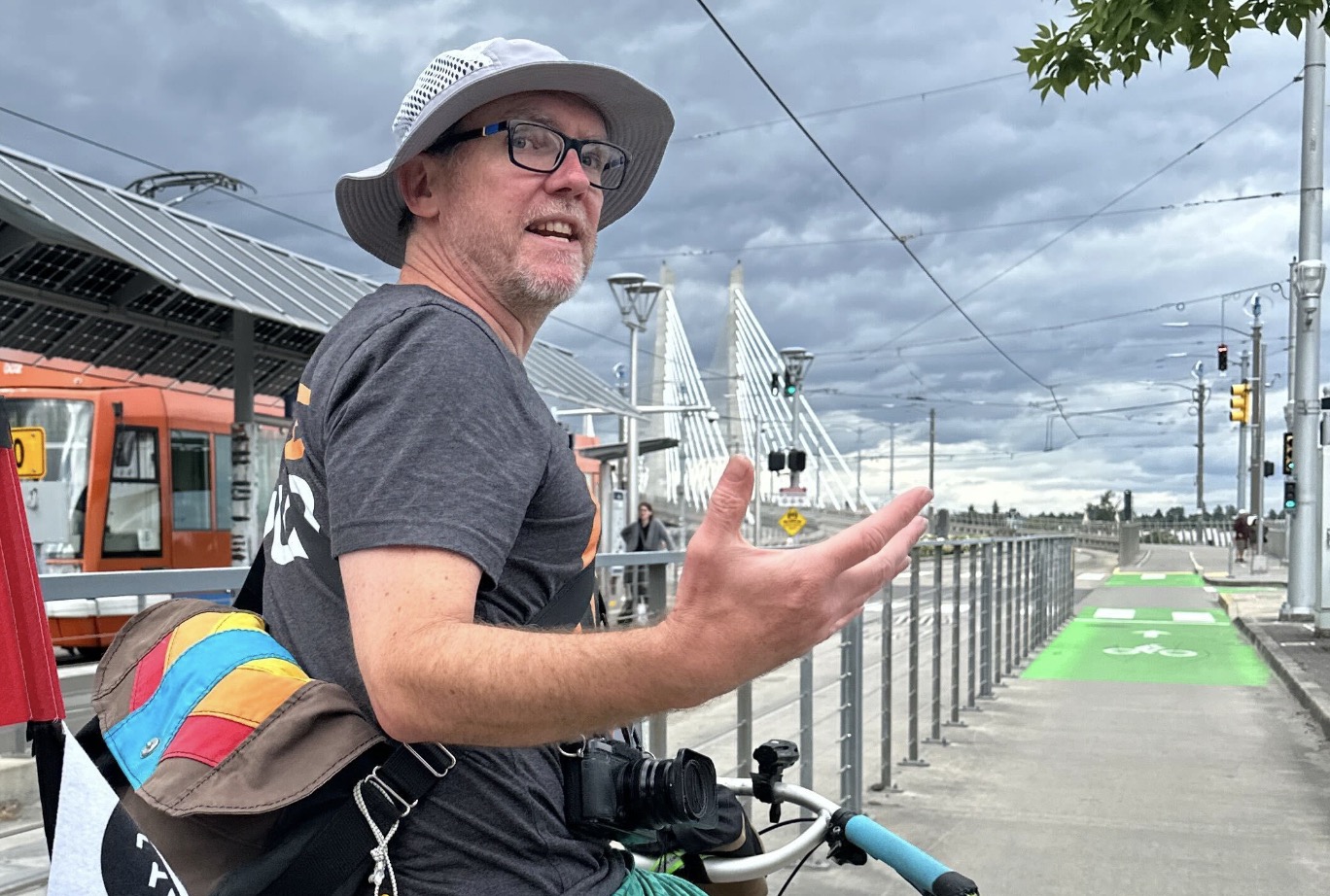
[Publisher’s Note: This is the final part of a three-part series by Portlander Aaron Kuehn (see part one and part two). Aaron is the outgoing chair of BikeLoud PDX, a local bike advocacy nonprofit. He recently completed the bikeway design workshop offered by the Transportation Research and Education Center based at Portland State University.]
OK, it’s time for the final push. You’ve already completed your 60% plans backed-up by research and well-established design standards. Let’s start on the final design phase:
Congratulations, you’ve reached the 90% design stage and your bikeway design is almost complete. For this final revision you might want to use mechanical pencils and a straightedge, or a computer to make your design look as precise as possible, and utilize every inch of the roadway.
Let’s pick up where we left off yesterday…
Step 11 – Dutch style
Everybody in bikeway design uses Dutch infrastructure as a standard of excellence. How can you get that Dutch look for your bikeway design? In general “the Dutch design approach focuses on maximizing the efficiency of the transportation system.” Bicycling is seen as the most efficient way to get around for most people, so it is prioritized. Your design should ooze effortless efficiency, like Nick Falbo, who presented the Dutch perspective in our workshop.
Unlike the MUTCD, the Dutch CROW Design Manual for Bicycle Traffic has no Standards. Dutch planners and engineers are entirely responsible for their decisions, and so are Dutch drivers — a cultural difference with geometric consequences, like their 3 inches of curb height separating bikeways from cars, vs our 6 inches. The CROW manual relies instead on five basic design principles:
1) Cohesion
Cohesion is about thoughtful network design. Since you are already following “desire lines” for your bikeway, this should be easy. If you run out of space at the edge of your paper, don’t just abruptly end your bikeway there. You see these abrupt endings in suburban bikeways and sidewalks. Continue your design onto another sheet of paper, or connect your bikeway to another facility — cohesively.
2) Directness
The goal of directness is to reduce travel time and guarantee less physical effort, making cycling a competitive transportation alternative. Bike boxes are a good example of directness, ushering bicycle riders to the front of the line.
A good example of in-directness is being forced to use a hilly parallel route that meanders through residential neighborhoods because the straight flat main street is too important to share with bikes. Don’t do that with your design, be direct!
Technical tip: The first two principles, cohesion and directness are often combined in the US as connectivity, which can result in a maze of indirect incohesive connections. Stay firm with your design principles.
3) Safety
Safety is the easiest design principle to achieve. Slow cars down near your bikeway with horizontal or vertical deflection. And instead of closing them, mark crossings and elevate them to sidewalk level.
4) Comfort
Comfort is mostly ignored for US bikeway design, which is why more people don’t bike. Is your bikeway easy for new riders to find and intelligible? Is riding your bikeway more comfortable than driving?
Design your bikeway wide enough for people to ride side by side, and adequately separate it from cars using concrete. Select a smooth and level route with minimal stops or nuisances. Use waymarking to make the bikeway legible and intuitive.
The Dutch are said to use a coffee test to check for bikeway smoothness. Does coffee spill from your open cup while you ride on your bikeway — even on a scooter? Coffee stains on your design will show you are serious about comfort.
5) Attractiveness
Bikeway attractiveness is the most elusive principle to design for. It requires public space investment, maintenance, and a commitment to a quality joyful experience. Quiet residential streets that already benefit from private investment are a shortcut to attractive bikeways.
You will want to show a mature tree canopy shading your design, with dappled light pooling around craftsman homes. Neighborhood Greenways in Portland are a good starting point. Redraw them in your design with smooth pavement, and handsome gateway diverters to filter out confused and impatient cut-through drivers.
Off-street multi-use paths like the Springwater Corridor benefit from their bucolic parallel waterways. More bikeway designs should be lovely off-street paths through wildlife refuges. Multi-use paths that parallel freeways can be cursed by urban ills. But even the grisly sections of the I-205 path can look better under the right light than many of our on-street bikeways that are chronically under-maintained.
Key point: For a successful bikeway that lures people to try riding bikes, and keeps them riding, make your design attractive, comfortable, safe, direct, and cohesive!
Beyond the Netherlands
Despite the continuing excellence of Dutch transportation planning, there are other inspiring bikeway examples to consider from around the world, like Barcelona, Bogotá, and Montreal.
Step 12 – Intersections and junctions
So far our bikeway design hasn’t considered intersections with other streets, because they are hard. But Don’t Give Up at the Intersection! A lot of planners and engineers just dump bicycle riders into the car lanes at intersections in “mixing zones,” and hope they make it back to the bikeway on the other side, but there are better ways.

If your design includes protected bike lanes, you should continue that separation through the intersection with a protected intersection that assigns more discrete spaces for conflicting movements.
You can reduce the number of conflict points by changing the geometry of the intersection, like with a protected intersection, a dedicated intersection, or a roundabout — or you can separate conflicting users by time using traffic signals.
Step 13 – Signal timing, the invisible urbanism
Even more than drivers, bicyclists are concerned with efficiency and speed like Peter Koonce, Portland Signals and Street Lighting Division Manager.
Peter explains the potential for signals in an article about work on the FX2 bus line: “Signal timing and operations can be powerful because they are imperceptible to many travelers, and time affects all users differently. PBOT intended to center its work by looking through the lenses of safety, equity, and the PBOT modal hierarchy. By prioritizing people walking, rolling, and riding transit through signal timing, operations, and Next Generation TSP, the region has invested their resources into a safer corridor for people historically underserved by their government.”

Peter is practicing a dark art of bikeway design — illuminated signal timing. Many bikeway designs don’t exploit the benefits of timing as much as they should. What you can’t do with geometry, you can do with time. You can approximate optimized signal timing in your design by showing green signals for bikes.
Your bikeway design should also show detector loops or devices for bikes at the intersection, and upstream so the signal changes just as riders arrive. Be sure to include the little blue confirmation light to let riders know they are detected — “the Peter Koonce high five to bicyclists!”
Step 14 – Rounded corners
According to the CROW manual, waiting for signals causes 85% of the delay to cyclists in built-up areas. Intersections are also where many crashes happen, and they can be a location where riders feel highly vulnerable. Your bikeway design can function without signal control at all using a roundabout instead. Roundabouts can achieve better safety and efficiency than signalized intersections using geometry alone, and they aren’t as hard to design as you think.
Like other streets, roundabouts work best with a single driving lane for cars, and a separate bikeway, instructor Drusilla Van Hengel told our workshop. Both of these lanes can be simple circles — easy. People walking are deprioritized at roundabouts and are expected to travel out of their way for safe crossings. Maybe your experimental bikeway design can show a more direct path for people walking at roundabouts, and you’ll become a famous traffic engineer!
Step 15 – Presentation
You did it! Now that your bikeway design is all polished up, and having rigorously followed every guide, policy, and best practice available, it’s time to publish. Share your complete bikeway design, partial design, or “concept of a plan” in the comments section to receive constructive criticism from your peers. Maybe elements of your innovative design will end up incorporated into a bikeway built near you!
Thanks for coming along on this design adventure with me. For full class credit, be sure to read parts one and two.
— This series is by Aaron Kuehn, a veteran bike advocate, Bike Happy Hour regular and former chair of BikeLoud who rides a Marin Pine Mountain with hi-viz streamers. Read the full series here.







